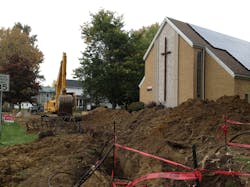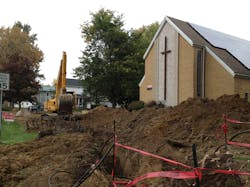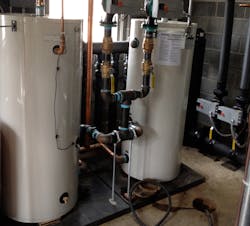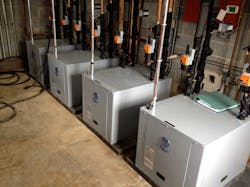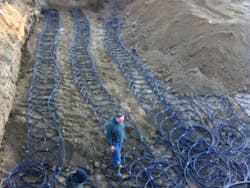Congregation embraces geothermal thanks to Buffalo GeoThermal Heating
By some accounts, the decision to move from a conventional oil heating system to a less traditional geothermal system was a leap of faith for the congregation of St. Michael’s Lutheran Church. But according to church council president Robert Richards, it was more like a sound business decision based on years of research.
St. Michael’s, a small church in rural Akron, New York, serves a congregation of 140 members and is home to a preschool that meets at the church Monday through Friday. Although the
15,000-sq.ft. structure was built in 1952, St. Michael’s 153-year-old congregation actually pre-dates the church by some 92 years. For many in the church, the desire to keep the doors open another 153 years inspired the move to geothermal.
Prior to this year, St. Michael’s relied on a three-boiler, oil-fueled heating system to provide heat to the 61-year-old structure. The 30-plus-year-old boilers consumed as much as $17,000 in oil each year, a bill Richards and others believed the church could no longer afford to pay, especially if the congregation hoped to survive and prosper well into the future. In their estimation, even a more efficient oil burner could not provide the financial relief the church desperately needed.
“Without question, new boilers would operate more efficiently,” Richards notes. “But we would continue to be linked to oil and its volatile pricing structure. To remain dependent on oil just made no sense, especially if other, more affordable options were available to us.”
Research begins
And so began the search for alternatives to oil and propane, the only fuel sources accessible to residents and businesses in the Wolcottsville area. Richards began reading about geothermal and took advantage of home shows in the Buffalo area to learn even more about the technology, talk with people who installed geothermal systems and get answers to his many questions.
Richards found out that there are many benefits to a geothermal system. First of all, a geothermal system delivers consistent temperatures and efficiencies that exceed those of conventional HVAC systems, offering savings as high as 70 percent for heating, cooling and hot water.
In addition to consistent temperatures, a geothermal system ensures good indoor air quality (IAQ). That’s because the system doesn’t require combustion and therefore produces none of the byproducts associated with combustion, including carbon monoxide, which can be dangerous if not vented properly. And, the average geothermal system lifespan exceeds 24 years, compared to 15 years for a more traditional heating and cooling system.
“The more I learned, the more impressed I was by the technology,” says Richards. “It is far more efficient than the system we had, it is much cheaper to operate and it’s good for the environment.
Contractors share best practices at WaterFurnace’s 2014 sales meeting
Historic home restoration incorporates modern renewable energy via geothermal system
“But it also required a tremendous financial investment on the part of our congregation — and I feared our membership would view a project that costly as something we could not afford to do. My response to that line of thinking was simple: We can’t afford not to do it.”
As Richards and others researched the possibility of installing a geothermal system, they engaged several area contractors to look at the church and provide proposals to do the work. One contractor quickly rose to the top — Jens Ponikau, part owner of Buffalo GeoThermal Heating.
“Jens was fantastic to work with,” Richards says. “He understood the technology, he explained it in terms so that we, too, could understand it, and he always put the best interests of the church first, designing a system that not only met our needs, but did so in the least intrusive way.”
Nevertheless, two years passed before St. Michael’s made the decision to work with Buffalo GeoThermal. During that time, geothermal technology evolved, offering a solution that better served the infrastructure of the church and its high-temperature baseboard radiators.
Baseboard units typically use copper pipe with aluminum fins inside a decorative outer shell. The operation of a baseboard radiation system like that at St. Michael’s depends on creating convection currents in a room. Air is warmed by the fin tubes, rises and displaces cool air. This process is difficult to sustain with the 130°F water most hydronic geothermal systems generate. WaterFurnace changed that.
“Last year, WaterFurnace introduced its 5 Series 502W12 high temperature hydronic heat pump, which is capable of delivering water at 150°F, making it the perfect replacement for a boiler,” explains Ponikau. “The availability of this technology meant I could offer St. Michael’s a geothermal solution that integrated with their existing distribution system, acting more like a plug and play system and significantly reducing installation costs.”
Hearing this news, Richards was even more convinced that geothermal was the way to go. But, he still needed to persuade other members of the church by helping them jump the price tag hurdle. His task was made more difficult by the church’s nonprofit status, which made it ineligible to receive attractive federal tax credits available to most homeowners and businesses that opt to install geothermal systems. In addition, as a religious organization, the church was barred from receiving grant money. Nevertheless, Richards moved forward, carefully laying out the case for geothermal and the positive impact it could have on the future of the church.
“Fortunately, we had time on our side,” says Richards. “Our boilers were still operating, so we weren’t in an emergency response situation. We had time to carefully research and then intelligently discuss the options before us and make an informed decision.”
Anything but traditional
In addition, the church was coming off a recent success story that involved another nontraditional approach to energy savings. Last summer the congregation entered a 15-year lease agreement with Buffalo-based Solar Liberty. The agreement provided for the installation and maintenance of a 21-kilowatt solar panel system designed to cover 80 percent of the church’s electricity and reduce its annual electric bill from $2,800 to less than $1,000.
“The solar system was working very well,” said Richards. “We were benefitting from significant savings, and it offered a power source for the geothermal system, should we decide to go that route.”
In the end, the congregation took a deep breath, came together and voted unanimously to install the geothermal system. One month later, the church was well on its way, its hardworking congregation having raised $70,000 in donations toward the project.
The 28-ton heating system that Buffalo GeoThermal installed includes four 7-ton, two-stage, high-temperature WaterFurnace 5 Series hydronic heat pumps, placed in a parallel configuration. As one unit reaches its most efficient operating condition, the next unit in line comes on, optimizing the system for efficiency. Two variable-speed circulating pumps provide redundancy in the event one fails, but run together, each at 50 percent of load design to further ensure an efficient system.
“In addition, the heat pumps respond to the temperature outdoors,” explains Ponikau. “That means they only produce enough hot water to satisfy the load at any given temperature. So, the system saves energy by not having to run at the less efficient high-load temperature.”
To further ensure efficiency, the church is divided into four zones. Whenever the valve in a zone opens to bring heat to the space, pressure inside the piping system drops, which sends a signal to the pumps to rev up, enabling the system to adjust to all circumstances. The system also features remote monitoring, so that heat can be turned on and the building warmed prior to the arrival of church members.
The other critical component of any geothermal system is the ground loop. In the case of St. Michael’s, space outside the church for a horizontal ground loop was tight, and the drilling associated with a vertical loop was cost prohibitive. To address the problems of limited space and limited funds, Ponikau proposed the installation of a stacked slinky system. Rather than using straight pipe, slinky coils use overlapped loops of piping laid out horizontally along the bottom of a trench. In the case of the church, Buffalo GeoThermal actually installed two slinky loops — one at a depth of eight feet and a second directly above it at a depth of five feet.
“This type of loop allows you to install about nine feet of pipe in each linear foot of trench, making for a significantly shorter trench, which saves space and speeds up the installation,” says Ponikau. “In this case, we buried 28,000 feet of polyethylene pipe in an area approximately 150 x 150 feet, which is really quite small for a 28-ton geothermal system.”
Ponikau completed work on the St. Michael’s project in March, and streams live data from the system on his company’s website, enabling readers to follow the performance of the geothermal system. According to Richards, the church is already reaping benefits for the small congregation.
“We’re experiencing huge savings in fuel costs — $10,000 annually — and our loan payments, with principal and interest, are actually less than our annual oil bill was,” says Richards. “It’s my hope that we can take the money we save and apply it to our 20-year loan, with the goal of paying off the loan in as few as 10 years. Once that happens, we’ll have a huge amount of breathing room.”
In the meantime, the small-town, self-described traditional church, is suddenly anything but traditional.
“We’ve suddenly become trendsetters,” says Richards. “Because we’re the first church in the county to use solar and geothermal, we regularly receive requests from other churches and contractors to see our system and hear our story.”
It’s a story Richards and the St. Michael’s congregation are only too eager to share.
“We’re excited to show other congregations, businesses and anybody else that’s interested what we’ve done and what they, too, can do. Call it whatever you want — a leap of faith or just a sound financial decision,” says Richards. “It’s working, and because of our success, I’m confident we’ll have a church to hand to our children and their children. I don’t think we could ask for a better legacy than that.”
